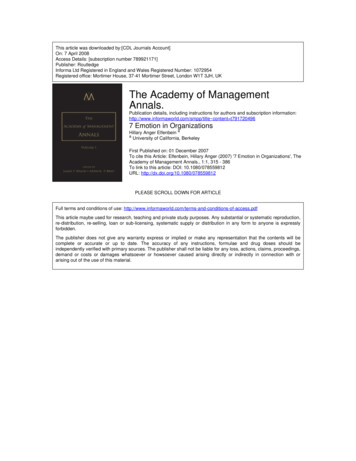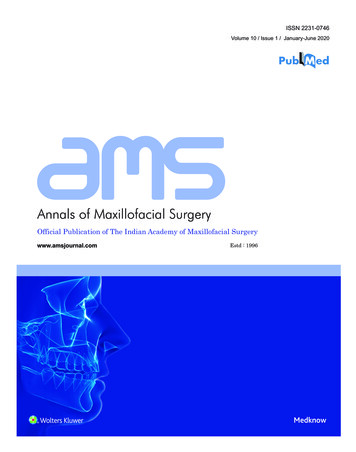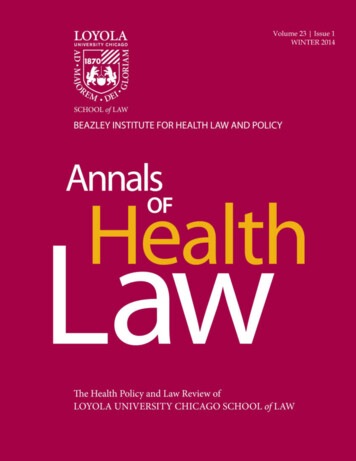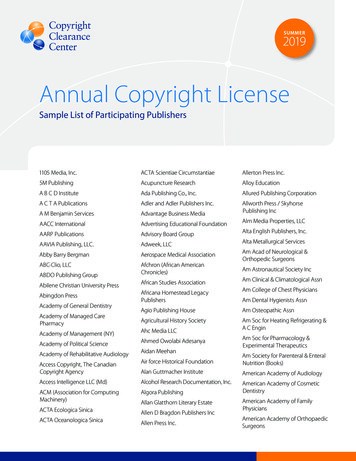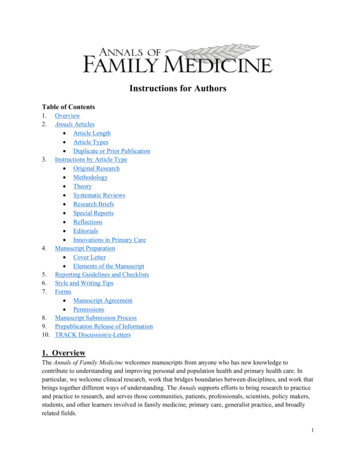
Transcription
Instructions for AuthorsTable of Contents1.2.OverviewAnnals Articles Article Length Article Types Duplicate or Prior Publication3. Instructions by Article Type Original Research Methodology Theory Systematic Reviews Research Briefs Special Reports Reflections Editorials Innovations in Primary Care4. Manuscript Preparation Cover Letter Elements of the Manuscript5. Reporting Guidelines and Checklists6. Style and Writing Tips7. Forms Manuscript Agreement Permissions8. Manuscript Submission Process9. Prepublication Release of Information10. TRACK Discussion/e-Letters1. OverviewThe Annals of Family Medicine welcomes manuscripts from anyone who has new knowledge tocontribute to understanding and improving personal and population health and primary health care. Inparticular, we welcome clinical research, work that bridges boundaries between disciplines, and work thatbrings together different ways of understanding. The Annals supports efforts to bring research to practiceand practice to research, and serves those communities, patients, professionals, scientists, policy makers,students, and other learners involved in family medicine, primary care, generalist practice, and broadlyrelated fields.1
All Annals of Family Medicine content is deposited in PubMed Central. This automatically fulfills theNIH Public Access Policy requirements for authors.All manuscripts must be submitted through the Annals’ online system, eJournalPress (see Instructions forSubmitting a Manuscript [PDF]). Most articles will fall into one of the categories described below.2. Annals ArticlesArticle LengthTightly written, short manuscripts often have high impact. A limited amount of additional material thatprovides extra depth may be submitted in appendixes. In all article categories below, we welcome brief manuscripts of 800-1100 words, 1-2 figures ortables, and a short abstract. This length is particularly appropriate for papers with a single, crisp,powerful idea or new ideas evaluated with small samples or other limitations. Longer articles that convey fully developed, rigorous exposition of a topic may be up to 2700words with 3-6 tables and/or figures. Some topics, including some qualitative research, mayrequire more words and fewer tables/figures. However, additional length must contribute addedvalue. 1200-2500 words is the most effective length for many topics. For example, seewww.annfammed.org/content/10/1/50.full and www.annfammed.org/content/11/3/258.full .Article TypesThe Annals publishes articles in the following categories. Original Research Research Briefs Methodology Theory Special Reports Reflections Editorials Innovations in Primary CareAnnals does not publish: case reports, clinical updates, expert reviews, fiction, poetry, or reviews ofbooks or software.Duplicate/Prior PublicationThe Annals considers manuscripts with the stipulation that the same or similar work has not beenpublished, accepted, or submitted for publication, in whole or in part, in any medium. If there is possibleduplicate or prior publication of your submission, describe it in the cover letter. Provide copies of allrelated materials written by the authors that have been previously published or are under consideration orin press elsewhere. See the Annals’ Policy on Duplicate/Prior Publication [PDF].2
3. Instructions by Article TypeOriginal Research Content: The Annals publishes original research from diverse perspectives, including: clinical,biomedical, behavioral, personal, community, and social sciences; and health services, health caresystems, and policy. Annals does not focus on educational research. We encourage the use ofparticipatory methods that involve key stakeholders at all phases of knowledge generation anddissemination.[1-3] Abstract: Up to 250 words, structured as Purpose, Methods, Results, Conclusions Study type: Clearly state the specific type of study in the methods section. Contextual factors: We encourage investigators to consider external validity throughout theresearch process. Identify and report contextual factors that are relevant to: 1) understanding whathappened in the study and why, and 2) transporting and re-inventing results in other times andsituations.[4-6] Reporting guidelines: Authors should follow the appropriate guideline and submit the associatedguideline checklist with the submission. See Reporting Guidelines and Checklists. Clinical trials: Reports of registered clinical trials should state their trial registry number at theend of the Abstract. Information on clinical trials registries is available at www.clinicaltrials.gov/and www.icmje.org/. Investigators must register clinical trials prospectively in a public trialsregistry when it is appropriate to the research design. A copy of the study protocol may beincluded as a Background File with the submission. Observational research: Reports of observational research should be driven by clearly stateddescriptive goals, or test stated hypotheses through an identified theoretical model of the processin question. Clearly identify the type of study and justify statistical choices. State which analyseswere pre-specified and hypothesis-driven, versus post-hoc. Quality improvement: Describe the quality improvement intervention's goals, the local problemaddressed, and the initiative's health care context and setting. Explore how the interventionimproved healthcare quality, safety, effectiveness, patient-centeredness, timeliness, cost,efficiency, and/or equity of health care. Qualitative research: Include a description of researchers' backgrounds and how this mightaffect the research process and interpretation. Pay particular attention to sampling and datacollection strategies, including the iterative processes used. Provide interpretive analyses thatdraw out larger meaning and theory, and tie in with existing knowledge. Do not simply groupthemes into obvious categories. Fully describe the procedures for data organization, analysis, andinterpretation, including strategies for validating results.Research Briefs Content: Research Briefs are concise articles that present research summaries, hypotheses andworks in progress. Length is 600-900 words with up to 10 references. Include a focusedIntroduction; succinct Methods; Results that convey the main findings without duplicatinginformation in the table/figure(s); a concise Discussion that puts the work into context, conveysthe main limitations, and suggests next steps for practice, policy, education or research. Includeno more than 2 tables and figures (total), focused on the main results.3
Abstract: Up to 100 words with no headings. The abstract should convey the purpose, briefmethods, main finding, and take-away lesson and implications.Methodology Content: Methodology articles propose new methods, extend existing methods, or provide newapproaches to integrating methods for primary care research. Include a brief, focused synthesis ofcurrently available research that places the proposed method in appropriate context. Methodsarticles may use real data for examples, but should present research only to illustratemethodological points. Abstract: Up to 250 words, typically structured as Purpose, Methods, Results, Conclusions.Theory Content: Theory articles explore problems unique to generalist practice and develop models ofhow family medicine and primary care can best meet important health care needs of individuals,families, or communities. Theory development can focus at the level of the illness, individual,community, patient-clinician interaction, practice organization, generalist/specialist interface, orhealth care system. New models should be tied to existing theory and grounded in research orother experience. We encourage work that transcends disciplinary boundaries. Abstract: Up to 250 words, either structured (as Purpose, Methods, Results, Conclusions) orunstructured, as best fits the topic.Systematic Reviews Content: The Annals welcomes systematic reviews that provide new insights from rigorous andcreative syntheses. Describe explicit methods to define questions, identify current knowledge, andpropose new work. Methods may include systematic reviews, meta-analyses, realist and narrativesyntheses, economic and decision analyses, and syntheses of qualitative research. Systematicreviews must advance practice, policy, theory or methods, or identify new research directions. Search strategy: Include the full Boolean search strategy, database name and provider, first andlast years searched, and which limits were applied. State when the search was conducted and bywhom. The complete search strategy for each database must be included as an appendix. Clinical guidelines: Systematic reviews of clinical topics should use and reference currentevidence-based clinical guidelines. Reporting guidelines: Authors should follow the appropriate guideline and submit the associatedguideline checklist. See Reporting Guidelines and Checklists. Abstract: Up to 250 words, structured as Purpose, Methods, Results, Conclusions. Annals does not publish clinical updates, expert reviews, or case reports.Special Reports Content: Special Reports address important timely topics that do not fit into other articlecategories. Topics should be relevant to improving primary care, health or health care. Abstract: Up to 250 words, either structured (as Purpose, Methods, Results, Conclusions) orunstructured, as best fits the topic.4
Reflections Content: Reflections presents essays by clinicians, scientists, patients, families, health careleaders, policy makers, and others. Essays may include stories of personal experience, persuasiveessays that present a point of view or course of action, or explanatory essays that shareinformation, describe a topic, or offer a definition. They should be concise and tightly written todeliver a clear, focused message. Abstract: Up to 150 words with no headings. Annals does not publish poetry or fiction.Editorials Annals publishes only invited editorials. All readers are encouraged to provide their perspectivesas e-letters in the TRACK discussion of Annals articles: www.AnnFamMed.org/letters .Innovations in Primary Care Content: Succinct stories of on-the-ground innovations that make a difference in primary healthcare. Includes novel approaches in primary care practice, empowerment of people/communities,or unexplored domains. Priority will be given to approaches that are transportable and scalable toother settings and contexts Topics may include (but are not limited to) partnerships; use oftechnology; novel ways of developing relationships; integrating, personalizing, or prioritizinghealth care or health promotion; reinventing useful ways of working in a new era. Format: Up to 550 words with no abstract. Use narrative style and first person voice. Follow thestructured format below, including the subheadings in CAPS.o Short title that clearly describes the nature of the innovation.o Author(s) name(s) and affiliation(s), plus corresponding author contact information.o THE INNOVATION: 1-2 opening sentences that state what the innovation is and whatproblem it is designed to solve.o WHO & WHERE: In 1-2 sentences, who is involved and where is the innovation carriedout? Provide context that others will need to apply or reinvent the activity in their setting.o HOW (longest section): A brief story about how the innovation works.o LEARNING: 1-3 sentences on what you’ve learned. What will help others replicate yourinnovation? How does it fit into the larger universe of practice, policy or innovation? Supplemental data:o Affiliations, references, acknowledgments, and most tables, figures, and illustrations willappear as online-only supplemental data. If any tables, figures, or images must appearwith the article in print, shorten the text to accommodate.o Appendixes can be used to provide more details e.g., examples and written materials.Appendixes are not included in the word count.5
4. Manuscript PreparationThe Annals follows the ICMJE “Recommendations for the Conduct, Reporting, Editing and Publicationof Scholarly Work in Medical Journals,” available at www.icmje.org/ . All article types require a complete title page and conflict of interest statement. Include allmanuscript elements in one document, if possible. Double-space the text. Use an 11- or 12-point font. Set 1-inch page margins. Number all pages, including the title page. Include a conflict of interest statement after the main text. Number references consecutively, as cited in the text. Place tables, figures and appendixes after the references. Background Files are intended only for the editors, not for publication. Submit all materials in the online eJournalPress system. See Instructions for Submitting aManuscript [PDF].Cover LetterSubmit a brief cover letter in eJournalPress. In 2-3 sentences, highlight the article's unique contribution to the literature and particularrelevance to Annals readers. List any related work by the authors that might represent prior or duplicate publication, andprovide a copy as a “Related Paper” file type in eJournalPress. See Annals’ Policy onDuplicate/Prior Publication [PDF]. If the study report followed a standard reporting guideline, state the name of the guideline andinclude the relevant checklist as a Guideline Checklist file type. Offer a brief rationale if theauthors did not follow a reporting guideline, particularly when a relevant, well-developedguideline exists (see Reporting Guidelines and Checklists).Elements of the ManuscriptInclude the following in the manuscript document. You will also be required to copy some of thisinformation into eJournalPress when submitting the manuscript.Title PageAll manuscripts must have a complete title page, including: Title of the manuscript. Provide a title that is concise, specific, engaging and informative. Do notuse abbreviations. Do not pose a question or over-emphasize conclusions. Information on titles isavailable in the AMA Manual of Style.[7] Authors’ full names, advanced degrees, institutional affiliations, and email addresses. SeeAnnals’ Policy on Authorship [PDF]. Corresponding author’s name, address, telephone and fax numbers, and email address. Support. List all sources of financial or other material support received for the work. Prior presentation(s) of the material, including name, date, and conference location. Word count for the main text (excluding title page, abstract, references, tables, figures). Numbers of tables, figures and appendixes.6
AbstractAbstracts are required for all manuscripts, except Innovations in Primary Care. Summarize mainpoints, rather than pointing to article content. Review the abstract after the manuscript is finalized, toensure consistency of key terms and numbers. Abstracts for Original Research, Methodology, Theory, Systematic Reviews, and SpecialReports may have up to 250 words and usually contain the following headings.Purpose: One sentence describing the problem being addressed and one sentence stating the studyobjective.Methods: Describe study design, setting, participants, interventions, measures, main outcomes,and analyses.Results: State the main findings of the study.Conclusions: Two sentences that, a) summarize the interpretation of the main findings and, b)provide context by stating the main implications of the findings for practice, policy, education orresearch. Some Methodology, Theory, and Special Reports may use an unstructured abstract that statesthe purpose or problem, summarizes major points, and ends with 1-2 short sentences on the majorconclusion and implications. Abstracts for Research Briefs are unstructured and up to 100 words. Abstracts for Reflections are unstructured and up to 150 words. They should present the problemaddressed or purpose of the essay and summarize major points, with a 1-2 sentence conclusion. Innovations in Primary Care do not require an abstract.KeywordsProvide at least 3 keywords. Copy the same keywords into the submission form. MEDLINE will selectsubject headings based on the content of the manuscript. Include important words and concepts in the titleand abstract, as these are searchable in MEDLINE and other databases.AbbreviationsList and define all abbreviations. Place this list after the keywords. Minimize the use of uncommonabbreviations to improve readability.TextOriginal Research articles usually include the sections below. In exceptional circumstances, authors maydeviate from this format. Methodology, Theory, Systematic Reviews, and Special Reports may usedifferent formats, as needed. Introduction: State clearly and concisely the article's unique contribution in the context of priorwork, conducted by the authors or others, and relevant bodies of theory. Methods: Describe how the study and analyses were conducted and ensure that the study can beassessed for validity and trustworthiness. Clearly state the type of study being reported. Do notdiscuss findings or conclusions in this section, and do not describe the study sample. A statementof IRB approval or exemption is required. Results: Report the study findings. Point to the tables and figures but do not repeat in wordswhat can be discerned from tables and figures. Statistical results should include confidenceintervals or exact P values, even for non-significant results. All statistical results should be7
reported according to the SAMPL Guidelines (Statistical Analyses and Methods in the PublishedLiterature). Qualitative results should focus on main domains and interpretive findings. Use a fewquotes to convey important points and to demonstrate the richness of the social phenomenondescribed. In most cases, quotes should be in the text, not in a table. If needed, use an appendix toconvey detailed qualitative findings and quotations.Discussion: Interpret the findings in the context of the study's strengths and limitations, existingknowledge, published literature, and state implications for practice, policy, education or futureresearch.AcknowledgmentsList those who have made substantive contributions to the work but do not meet the criteria forauthorship (see Annals’ Policy on Authorship [PDF]). Authors must retain written permission from eachperson acknowledged.Conflict of Interest StatementProvide a statement of all potential, perceived, or real conflicts of interest for each author. If an author hasno perceived conflicts, state "none declared." See Annals’ Policy on Conflict of Interest [PDF].ReferencesAuthors are responsible for ensuring the accuracy of references.Format numbered references in accordance with the AMA Manual of Style[7] or the ICMJErecommendations: www.nlm.nih.gov/bsd/uniform requirements.html or icmje.org/recommendations/. Sample journal article reference:Epstein RM, Street RL Jr. The values and value of patient-centered care. Ann Fam Med.2011;9:100-103. Sample book reference:Starfield B. Primary care concept, evaluation and policy. New York, NY: Oxford UniversityPress; 1992. Sample e-letter reference:Stulberg D. Important study on improving maternity care [eletter]. Ann Fam Med. 11 June 2021.Tables and Figures Tables and figures should convey meaning independent of the article text. For each table and figure, provide a brief descriptive title and clear, succinct headings for eachrow and column. Include footnotes as needed to allow readers to interpret a table independent ofthe text. Present each table or figure on a separate page, numbered in the order it appears in the text.Tables, figures and appendixes should be placed at the end of the manuscript, after the referencesection. Tables and figures adapted from other sources present particular challenges. It can take months toreceive permission to publish adapted materials, and permission is not always granted. Considerusing a new or existing figure or table instead of adapting from another source.8
Appendixes A limited amount of material that adds extra depth to an article may be published in an appendix,e.g., detailed quotations from qualitative studies, database search strategies for systematicreviews, analysis plans, detailed sensitivity analyses, intervention materials, model details, andquestionnaires or other research instruments. Refer to each appendix in the main text. Follow the same standards and style as in the body of thearticle. Appendixes should be included at the end of the main manuscript document. Place appendixes after tables/figures. Appendixes will be published as is; they will not be editedor formatted by the Annals. The author is responsible for ensuring that they are clear, accurate,and appropriately formatted. The Annals will consider posting multimedia materials that provide additional insights, contextualinformation, or personal reflections. All materials are subject to approval by the editors.Supplemental Files and Original Data Supporting documentation and files that might assist the editors in evaluating the manuscriptshould be uploaded under the relevant file types: Background File, Guideline Checklist, orRelated Paper.5. Reporting Guidelines and ChecklistsFor many kinds of research, widely accepted reporting guidelines can improve the quality of publishedwork and benefit authors, peer reviewers, readers, patients, and communities. Reporting guidelines areimperfect and can be challenging to apply to some work, such as mixed methods studies or programevaluations. For most types of studies, however, they can improve the consistency, quality and rigor ofreports.The Annals encourages authors to review the list below and use appropriate guidelines to frame theirwork. The choice to use or not use a reporting guideline should be explained in the submission coverletter. If a reporting guideline was used, include the completed guideline checklist as a separate file.The EQUATOR Network provides a comprehensive, up-to-date and searchable clearinghouse ofreporting guidelines at www.equator-network.org/ .Type of StudyRandomizedcontrolled studiesWhat reporting guidelines are available?CONSORTSPIRIT (trial protocols)Guideline extensions are available for pragmatictrials, cluster RCTs, non-inferiority andequivalence trials, and trials of nonpharmacological interventions. Specific extensionsoutline the presentation of data, harms, andabstracts.ChecklistsCONSORT 2010Checklist [DOC]SPIRIT Checklist9
ObservationalstudiesSystematic reviews;meta-analysesStudies of diagnosticaccuracyQualitativeinterviews; focusgroupsQualityimprovementBasic statisticalreportingSTROBE (Strengthening the Reporting ofObservational studies in Epidemiology)General checklist for all types of observationalstudies; specific checklists available for cohort,case-control, and cross-sectional studies.PRISMA (Preferred Reporting Items forSystematic Reviews and Meta-Analyses)General systematic reviews and meta-analyses.MOOSE (Meta-analysis of Observational Studiesin Epidemiology)Focuses on reviews of observational studies.RAMESES (Realist and Meta-narrative EvidenceSyntheses: Evolving Standards)ENTREQ (Enhancing Transparency in Reportingthe synthesis of Qualitative research)STARD (Standards for Reporting Diagnosticaccuracy studies)COREQ (Consolidated criteria for ReportingQualitative research)SQUIRE (Standards for Quality ImprovementReporting Excellence)SAMPL (Statistical Analyses and Methods in thePublished Literature)STROBE ChecklistsPRISMA Checklist andFlow diagram [DOC]MOOSE Checklist [PDF]RAMESES StandardsENTREQ Statement[PDF]STARD Checklist andFlow diagram [PDF]COREQ ChecklistSQUIRE 2.0 Checklist[PDF]SAMPL Guidelines [PDF]6. Style and Writing TipsThe Annals encourages tightly written manuscripts with a clear main message, as these often engage abroad readership. We generally follow the AMA Manual of Style.[7] Please write in the active voice and first person. Make every effort to eliminate unnecessary words. When you have finished writing themanuscript, we recommend reading it again to trim unnecessary words. Write in a style appropriate to your audience(s). Prior to submitting your work, consider asking amember of your target audience to read the article for clarity and succinctness.7. FormsManuscript AgreementAuthors will be asked to complete a Manuscript Agreement [PDF] if they are invited to submit a revisedmanuscript after peer review. It is not necessary to submit the forms prior to that time.10
Permissions For all manuscripts, authors should ensure that individuals mentioned are not identifiable toanyone, including themselves. If individuals might be identified, authors must provide writtenpermission with their submission. See Consent of Individual to Publish Material [PDF]. If the manuscript includes material that has been published in print or online, including text,illustrations, or tables, the original authors and sources must be fully identified. Annals of Family Medicine is published both in print and online, so authors must obtainpermission to publish borrowed materials in all forms and media (see Tables and Figures).Authors are responsible for any associated fees.Return forms by email, fax, or post:Email: AnnFamMed@umich.eduFax:(734) 936-6006Postal address: Annals of Family Medicine300 North Ingalls Street, NI-4D09Ann Arbor, MI 48109Telephone: (734)763-74548. Manuscript Submission ProcessAll manuscripts are submitted through our online system hosted by eJournalPress. See Instructions forSubmitting a Manuscript [PDF].9. Prepublication Release of InformationSee Annals’ Policy on Prepublication Release of Information and Embargo [PDF].10. e-LettersWe encourage readers, authors, and other interested individuals and groups to join in the discussion ofAnnFamMed articles. e-letters, or comments, may be brief and informal (as short as one sentence) ormore formal commentaries. They should generally be limited to 400 words and 5 references. Each articlecontains links to read and submit comments. We ask authors of accepted manuscripts to identify potentiale-letter writers from diverse audiences for the discussion. To read recent e-letters, visitwww.AnnFamMed.org/eletters.11
References1. Westfall JM, VanVorst RF, Main DS, Herbert C. Community-based participatory research in practicebased research networks. Ann Fam Med. 2006;4(1):8-14. doi: https://dx.doi.org/10.1370/afm.5112. Macaulay AC, Nutting PA. Moving the frontiers forward: incorporating community-basedparticipatory research into practice-based research networks. Ann Fam Med. 2006;4(1):4-7. doi:https://dx.doi.org/10.1370/afm.5093. Macaulay AC, Commanda LE, Freeman WL, et al. Participatory research maximises community andlay involvement. North American Primary Care Research Group. BMJ. 1999;319(7212):774-778. doi:http://dx.doi.org/10.1136/bmj.319.7212.7744. Tomoaia-Cotisel A, Scammon DL, Waitzman NJ, et al. Context matters: the experience of 14 researchteams in systematically reporting contextual factors important for practice change. Ann Fam Med.2013;11(Suppl 1):S115-S123. doi: https://dx.doi.org/10.1370/afm.15495. Stange KC, Glasgow R. Considering and reporting important contextual factors in research on thepatient-centered medical home. Rockville, MD: Agency for Healthcare Research and Quality; June2013. AHRQ publication no. 13-0045-EF. Available attachments/ContextualFactors.pdf6. Stange KC. In this issue: practice change—context matters. Ann Fam Med. 2013;11(3):198-199. doi:http://dx.doi.org/10.1370/afm.15327. Iverson C, Christiansen S, Flanagin A, et al. AMA manual of style: a guide for authors and editors.10th ed. New York, NY: Oxford University Press; 2007.Updated June 15, 202112
Annals of Family Medicine. content is deposited in . PubMed Central. This automatically fulfills the NIH Public Access Policy requirements for authors. All manuscripts must be submitted through the . Annals ' online system, eJournalPress (see . Instructions for Submitting a Manuscript [PDF]). Most articles will fall into one of the categories .

